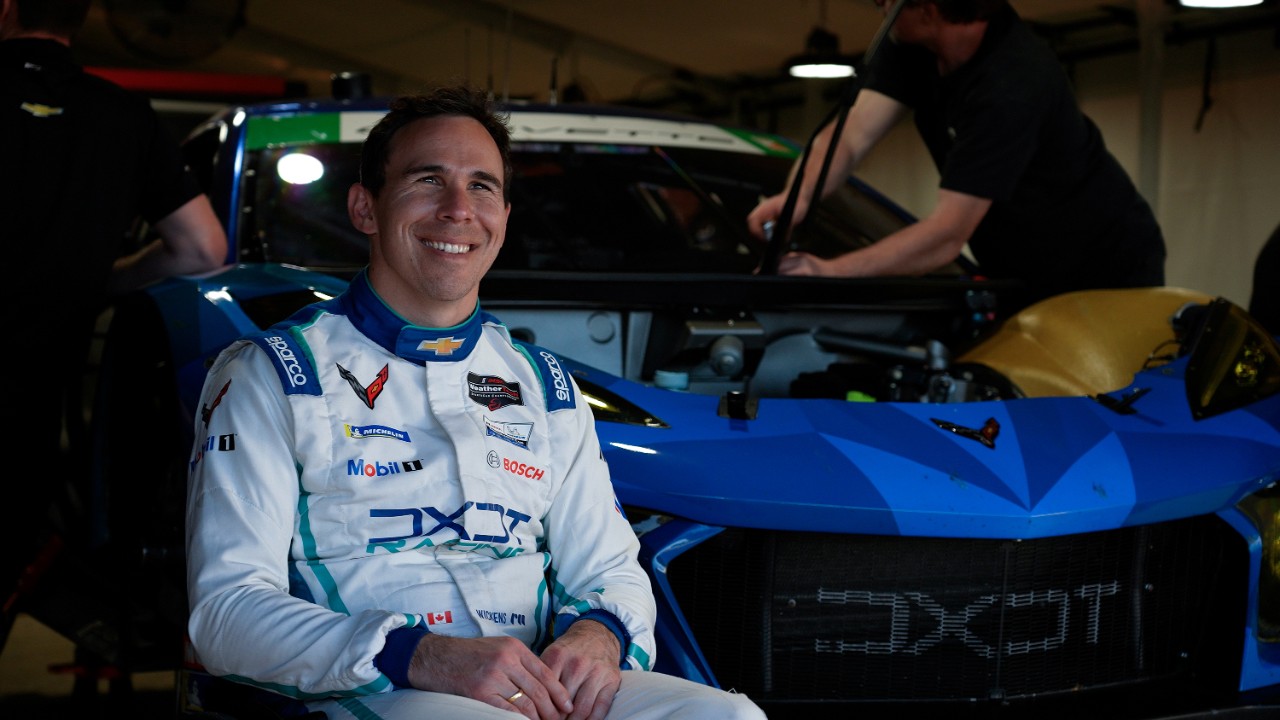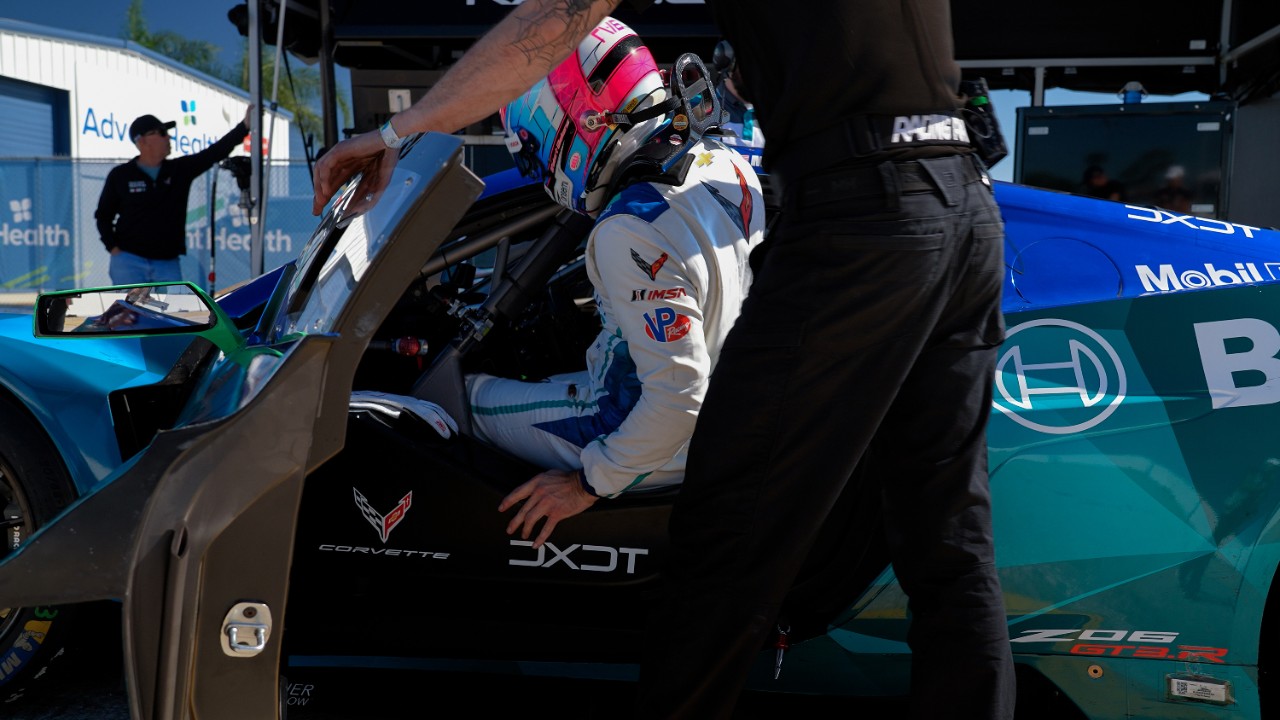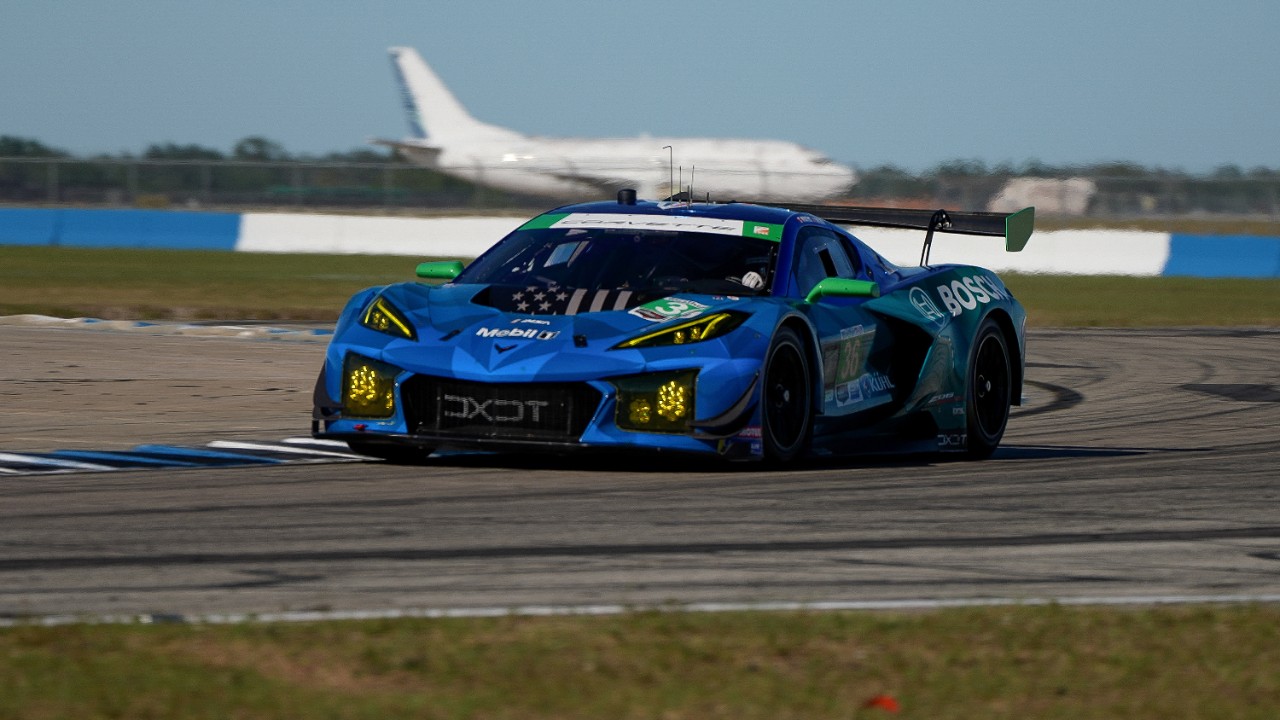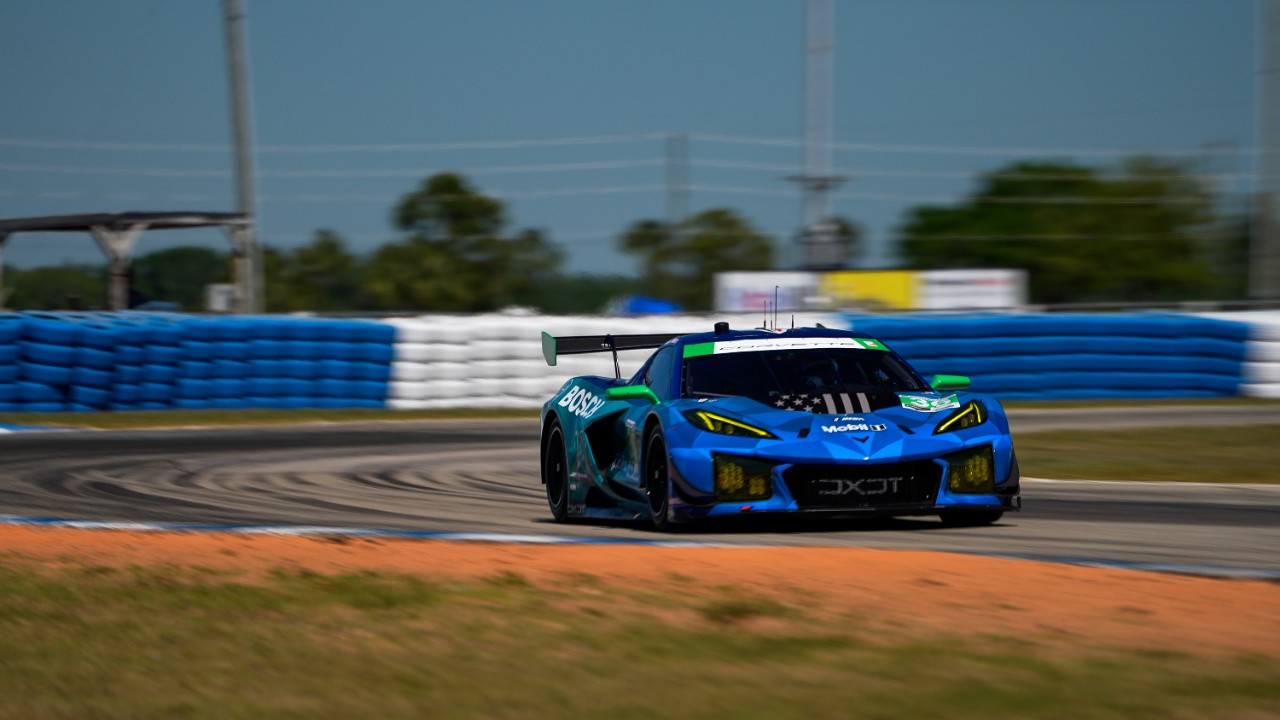By Bob Sorokanich, Senior Editor, GM News
By Bob Sorokanich, Senior Editor, GM News
This weekend, professional racing driver Robert Wickens will slide behind the wheel of the No. 36 DXDT Racing Corvette Z06 GT3.R and complete a journey that’s been seven grueling years in the making.
When the odyssey began, Wickens was on top of the motorsports world. He’d dedicated his entire young life to becoming a top-tier driver. From his very first go-kart race as a preteen, his natural talent was obvious. His parents sold their home and moved the family in with an uncle to raise funds to support Wickens’ early career.
In 2018, he got called up to IndyCar, the pinnacle of American open-wheel racing, where he was regarded as a once-in-a-lifetime talent. IndyCar credibly bills itself as “the fastest racing on earth,” a daunting prospect for newcomers. Wickens’ supernatural poise, and a blistering performance at his first Indianapolis 500, earned him the title Rookie of the Year.
That same season, a catastrophic crash at the ABC Supply 500 at Pocono Raceway nearly ended it all. A spinal fracture left Wickens with paraplegia, unable to use his legs. Doctors told him he’d never walk again, but Wickens hurtled into rehab with a racer’s focus. Thirteen months after the crash that nearly killed him, he paid out a hospital-bed promise to his fiancée, standing unassisted and even dancing at their wedding.
Caption: Robert Wickens during preseason testing at Sebring. Photo Credit: Amanda Jeannette, DXDT Racing.
In 2022, Wickens – who primarily uses a wheelchair – returned to full-time racing, competing in the Michelin Pilot Challenge. Racing in the Touring Car class, driving a sport sedan fitted with hand controls for the accelerator and brake, Wickens was the season champion in 2023. For the 36-year-old Canadian, that triumph was a steppingstone toward a bigger target.
“The goal was always to get back to the highest forms of motorsport again,” Wickens said in an interview with GM News. “And in my opinion, the Weather Tech series is exactly that.” On Saturday, Wickens will join the grid at the Acura Grand Prix of Long Beach, competing in the Grand Touring Daytona (GTD) class of the IMSA WeatherTech SportsCar Championship – his first top-tier race since his 2018 crash.
Wickens cracks an irrepressible grin when he talks about the Corvette he’ll drive in this weekend’s race.
“Regardless of what I've done in my past, driving the Corvette Z06 GT3.R, it’s frankly a dream come true,” he said. “The first time I drove the car, seeing that Corvette logo on the steering wheel, it just put a smile on my face. Every time you see the car, you want to drive it fast.”
Caption: At the Long Beach race, Wickens will share driving duties with teammate Tommy Milner. “We’ve been working really hard on driver-change practice,” Wickens said. “We need to get the change done in about 15 seconds so we don’t lose track position.” Photo Credit: Amanda Jeannette, DXDT Racing.
Wickens uses hand controls mounted to the steering wheel to accelerate and brake, but there’s no off-the-shelf system for adding these controls to a dedicated race car. Chevrolet partnered with the DXDT Racing team, vehicle constructor Pratt Miller, and equipment supplier Bosch to create a robust and reliable hand-control system that could stand up to the punishment of top-tier racing.
The system had to be unobtrusive enough for Wickens to share his car with Corvette factory racing driver Tommy Milner, who will co-drive at Long Beach using the car’s conventional foot pedals. The Bosch Electronic Brake System was adapted from technology used in the international Le Mans Daytona Hybrid racing class, and was optimized to give Wickens the precision control and feedback that a racer of his caliber demands.
For General Motors, this collaboration was a natural fit. When Wickens takes to the track this weekend, his car will proudly wear the logo of GM Able, an employee resource group focused on promoting vehicle accessibility and building community and support for GM employees with disabilities and caregivers.
“I felt like I was comfortable straight away,” Wickens said about the No. 36 Corvette. “Hats off to Bosch, General Motors, Pratt Miller, and DXDT for collaborating and integrating my Bosch EBS brake system. It felt like it belonged naturally in that car. It was just a seamless integration.”
Caption: Wickens driving test laps at Sebring. “Every time you see the car, you just want to drive it fast,” he said. Photo Credit: Amanda Jeannette, DXDT Racing.
Wickens will compete in five races in the 2025 IMSA SportsCar Championship. If all goes well, he hopes to race in all 11 events on the calendar for 2026. But there’s a greater goal in developing Wickens’ Corvette race car.
“The biggest challenge is, there’s no curriculum for building a race car with hand controls,” Wickens told GM News. “When an able-bodied driver gets into a new car for the first time, they don’t have to learn the geography of the system.” The standard accelerator and brake pedals are always in the same place, but hand controls have no such convention in race cars.
“For us, you have to learn, the brakes are here, the throttle is down here, and you need to figure out where your hands need to be at all times.” Add in the gearshift paddles and more than a dozen adjustment knobs and buttons on a GTD race car’s steering wheel, and it all becomes a juggling act performed through high-speed straightaways and hairpin corners. “I would love to create a curriculum for future generations, from karts all the way up to the highest levels of racing – a box to work in, where you know the position of the brake and throttle no matter what you’re driving,” Wickens said.
Caption: “If we can succeed at Long Beach, I think it’s only going to give us motivation for the rest of the year,” Wickens told GM News. Photo Credit: Amanda Jeannette, DXDT Racing.
Those solutions will come. Right now, Wickens is focused on preparing for his return to top-tier racing on Saturday.
“Everyone always overthinks their first race, because you've had an entire winter to think about it,” he jokes. “It makes me so happy to be in this competition, to see the list of drivers on the grid in Long Beach. That's the exact competition I want. Every lap, every corner they're fighting, and that's exactly what I want in my career. If I can succeed there, I feel like I can succeed anywhere.”
From the beginning, General Motors was directly involved in making Wickens’ Corvette race-ready. “We are proud to be part of this effort alongside DXDT Racing, Pratt Miller, Bosch and of course Robert Wickens,” said Mark Stielow, Director, GM Motorsports Competition Programs. “It means a tremendous amount for Robert and Bosch to choose the Corvette Z06 GT3.R and DXDT Racing as they achieve their goal of making racing more inclusive to all competitors around the world.”
“I wouldn't be talking to you right now if it wasn't for the help of GM, Bosch and DXDT to believe in this,” Wickens said. “It was such a collaborative effort to make this all possible. Everyone had to make sacrifices, and everyone had to believe something like this could be possible. I'm so grateful to be aligned with all these people, and I’m proud to represent GM Able.”

This weekend, professional racing driver Robert Wickens will slide behind the wheel of the No. 36 DXDT Racing Corvette Z06 GT3.R and complete a journey that’s been seven grueling years in the making.
When the odyssey began, Wickens was on top of the motorsports world. He’d dedicated his entire young life to becoming a top-tier driver. From his very first go-kart race as a preteen, his natural talent was obvious. His parents sold their home and moved the family in with an uncle to raise funds to support Wickens’ early career.
In 2018, he got called up to IndyCar, the pinnacle of American open-wheel racing, where he was regarded as a once-in-a-lifetime talent. IndyCar credibly bills itself as “the fastest racing on earth,” a daunting prospect for newcomers. Wickens’ supernatural poise, and a blistering performance at his first Indianapolis 500, earned him the title Rookie of the Year.
That same season, a catastrophic crash at the ABC Supply 500 at Pocono Raceway nearly ended it all. A spinal fracture left Wickens with paraplegia, unable to use his legs. Doctors told him he’d never walk again, but Wickens hurtled into rehab with a racer’s focus. Thirteen months after the crash that nearly killed him, he paid out a hospital-bed promise to his fiancée, standing unassisted and even dancing at their wedding.

In 2022, Wickens – who primarily uses a wheelchair – returned to full-time racing, competing in the Michelin Pilot Challenge. Racing in the Touring Car class, driving a sport sedan fitted with hand controls for the accelerator and brake, Wickens was the season champion in 2023. For the 36-year-old Canadian, that triumph was a steppingstone toward a bigger target.
“The goal was always to get back to the highest forms of motorsport again,” Wickens said in an interview with GM News. “And in my opinion, the Weather Tech series is exactly that.” On Saturday, Wickens will join the grid at the Acura Grand Prix of Long Beach, competing in the Grand Touring Daytona (GTD) class of the IMSA WeatherTech SportsCar Championship – his first top-tier race since his 2018 crash.
Wickens cracks an irrepressible grin when he talks about the Corvette he’ll drive in this weekend’s race.
“Regardless of what I've done in my past, driving the Corvette Z06 GT3.R, it’s frankly a dream come true,” he said. “The first time I drove the car, seeing that Corvette logo on the steering wheel, it just put a smile on my face. Every time you see the car, you want to drive it fast.”

Wickens uses hand controls mounted to the steering wheel to accelerate and brake, but there’s no off-the-shelf system for adding these controls to a dedicated race car. Chevrolet partnered with the DXDT Racing team, vehicle constructor Pratt Miller, and equipment supplier Bosch to create a robust and reliable hand-control system that could stand up to the punishment of top-tier racing.
The system had to be unobtrusive enough for Wickens to share his car with Corvette factory racing driver Tommy Milner, who will co-drive at Long Beach using the car’s conventional foot pedals. The Bosch Electronic Brake System was adapted from technology used in the international Le Mans Daytona Hybrid racing class, and was optimized to give Wickens the precision control and feedback that a racer of his caliber demands.
For General Motors, this collaboration was a natural fit. When Wickens takes to the track this weekend, his car will proudly wear the logo of GM Able, an employee resource group focused on promoting vehicle accessibility and building community and support for GM employees with disabilities and caregivers.
“I felt like I was comfortable straight away,” Wickens said about the No. 36 Corvette. “Hats off to Bosch, General Motors, Pratt Miller, and DXDT for collaborating and integrating my Bosch EBS brake system. It felt like it belonged naturally in that car. It was just a seamless integration.”

Wickens will compete in five races in the 2025 IMSA SportsCar Championship. If all goes well, he hopes to race in all 11 events on the calendar for 2026. But there’s a greater goal in developing Wickens’ Corvette race car.
“The biggest challenge is, there’s no curriculum for building a race car with hand controls,” Wickens told GM News. “When an able-bodied driver gets into a new car for the first time, they don’t have to learn the geography of the system.” The standard accelerator and brake pedals are always in the same place, but hand controls have no such convention in race cars.
“For us, you have to learn, the brakes are here, the throttle is down here, and you need to figure out where your hands need to be at all times.” Add in the gearshift paddles and more than a dozen adjustment knobs and buttons on a GTD race car’s steering wheel, and it all becomes a juggling act performed through high-speed straightaways and hairpin corners. “I would love to create a curriculum for future generations, from karts all the way up to the highest levels of racing – a box to work in, where you know the position of the brake and throttle no matter what you’re driving,” Wickens said.

Those solutions will come. Right now, Wickens is focused on preparing for his return to top-tier racing on Saturday.
“Everyone always overthinks their first race, because you've had an entire winter to think about it,” he jokes. “It makes me so happy to be in this competition, to see the list of drivers on the grid in Long Beach. That's the exact competition I want. Every lap, every corner they're fighting, and that's exactly what I want in my career. If I can succeed there, I feel like I can succeed anywhere.”
From the beginning, General Motors was directly involved in making Wickens’ Corvette race-ready. “We are proud to be part of this effort alongside DXDT Racing, Pratt Miller, Bosch and of course Robert Wickens,” said Mark Stielow, Director, GM Motorsports Competition Programs. “It means a tremendous amount for Robert and Bosch to choose the Corvette Z06 GT3.R and DXDT Racing as they achieve their goal of making racing more inclusive to all competitors around the world.”
“I wouldn't be talking to you right now if it wasn't for the help of GM, Bosch and DXDT to believe in this,” Wickens said. “It was such a collaborative effort to make this all possible. Everyone had to make sacrifices, and everyone had to believe something like this could be possible. I'm so grateful to be aligned with all these people, and I’m proud to represent GM Able.”